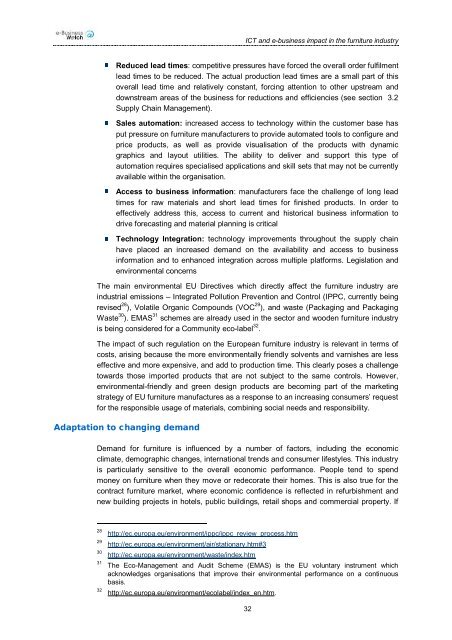ICT and e-Business Impact in the Furniture Industry - empirica
ICT and e-Business Impact in the Furniture Industry - empirica
ICT and e-Business Impact in the Furniture Industry - empirica
- No tags were found...
You also want an ePaper? Increase the reach of your titles
YUMPU automatically turns print PDFs into web optimized ePapers that Google loves.
<strong>ICT</strong> <strong>and</strong> e-bus<strong>in</strong>ess impact <strong>in</strong> <strong>the</strong> furniture <strong>in</strong>dustryReduced lead times: competitive pressures have forced <strong>the</strong> overall order fulfilmentlead times to be reduced. The actual production lead times are a small part of thisoverall lead time <strong>and</strong> relatively constant, forc<strong>in</strong>g attention to o<strong>the</strong>r upstream <strong>and</strong>downstream areas of <strong>the</strong> bus<strong>in</strong>ess for reductions <strong>and</strong> efficiencies (see section 3.2Supply Cha<strong>in</strong> Management).Sales automation: <strong>in</strong>creased access to technology with<strong>in</strong> <strong>the</strong> customer base hasput pressure on furniture manufacturers to provide automated tools to configure <strong>and</strong>price products, as well as provide visualisation of <strong>the</strong> products with dynamicgraphics <strong>and</strong> layout utilities. The ability to deliver <strong>and</strong> support this type ofautomation requires specialised applications <strong>and</strong> skill sets that may not be currentlyavailable with<strong>in</strong> <strong>the</strong> organisation.Access to bus<strong>in</strong>ess <strong>in</strong>formation: manufacturers face <strong>the</strong> challenge of long leadtimes for raw materials <strong>and</strong> short lead times for f<strong>in</strong>ished products. In order toeffectively address this, access to current <strong>and</strong> historical bus<strong>in</strong>ess <strong>in</strong>formation todrive forecast<strong>in</strong>g <strong>and</strong> material plann<strong>in</strong>g is criticalTechnology Integration: technology improvements throughout <strong>the</strong> supply cha<strong>in</strong>have placed an <strong>in</strong>creased dem<strong>and</strong> on <strong>the</strong> availability <strong>and</strong> access to bus<strong>in</strong>ess<strong>in</strong>formation <strong>and</strong> to enhanced <strong>in</strong>tegration across multiple platforms. Legislation <strong>and</strong>environmental concernsThe ma<strong>in</strong> environmental EU Directives which directly affect <strong>the</strong> furniture <strong>in</strong>dustry are<strong>in</strong>dustrial emissions – Integrated Pollution Prevention <strong>and</strong> Control (IPPC, currently be<strong>in</strong>grevised 28 ), Volatile Organic Compounds (VOC 29 ), <strong>and</strong> waste (Packag<strong>in</strong>g <strong>and</strong> Packag<strong>in</strong>gWaste 30 ). EMAS 31 schemes are already used <strong>in</strong> <strong>the</strong> sector <strong>and</strong> wooden furniture <strong>in</strong>dustryis be<strong>in</strong>g considered for a Community eco-label 32 .The impact of such regulation on <strong>the</strong> European furniture <strong>in</strong>dustry is relevant <strong>in</strong> terms ofcosts, aris<strong>in</strong>g because <strong>the</strong> more environmentally friendly solvents <strong>and</strong> varnishes are lesseffective <strong>and</strong> more expensive, <strong>and</strong> add to production time. This clearly poses a challengetowards those imported products that are not subject to <strong>the</strong> same controls. However,environmental-friendly <strong>and</strong> green design products are becom<strong>in</strong>g part of <strong>the</strong> market<strong>in</strong>gstrategy of EU furniture manufactures as a response to an <strong>in</strong>creas<strong>in</strong>g consumers’ requestfor <strong>the</strong> responsible usage of materials, comb<strong>in</strong><strong>in</strong>g social needs <strong>and</strong> responsibility.Adaptation to chang<strong>in</strong>g dem<strong>and</strong>Dem<strong>and</strong> for furniture is <strong>in</strong>fluenced by a number of factors, <strong>in</strong>clud<strong>in</strong>g <strong>the</strong> economicclimate, demographic changes, <strong>in</strong>ternational trends <strong>and</strong> consumer lifestyles. This <strong>in</strong>dustryis particularly sensitive to <strong>the</strong> overall economic performance. People tend to spendmoney on furniture when <strong>the</strong>y move or redecorate <strong>the</strong>ir homes. This is also true for <strong>the</strong>contract furniture market, where economic confidence is reflected <strong>in</strong> refurbishment <strong>and</strong>new build<strong>in</strong>g projects <strong>in</strong> hotels, public build<strong>in</strong>gs, retail shops <strong>and</strong> commercial property. If2829303132http://ec.europa.eu/environment/ippc/ippc_review_process.htmhttp://ec.europa.eu/environment/air/stationary.htm#3http://ec.europa.eu/environment/waste/<strong>in</strong>dex.htmThe Eco-Management <strong>and</strong> Audit Scheme (EMAS) is <strong>the</strong> EU voluntary <strong>in</strong>strument whichacknowledges organisations that improve <strong>the</strong>ir environmental performance on a cont<strong>in</strong>uousbasis.http://ec.europa.eu/environment/ecolabel/<strong>in</strong>dex_en.htm.32
















